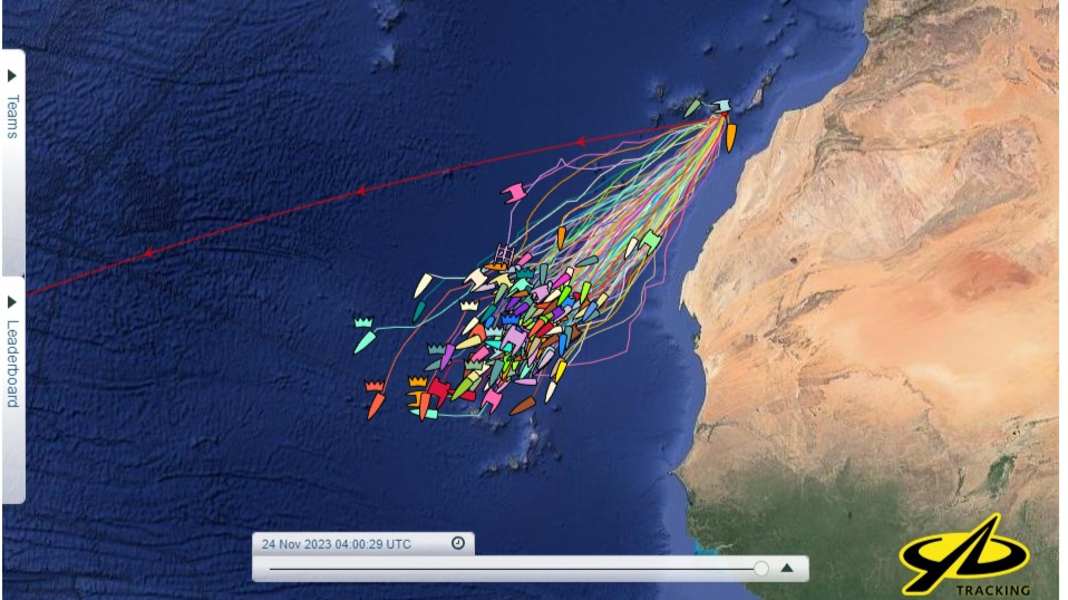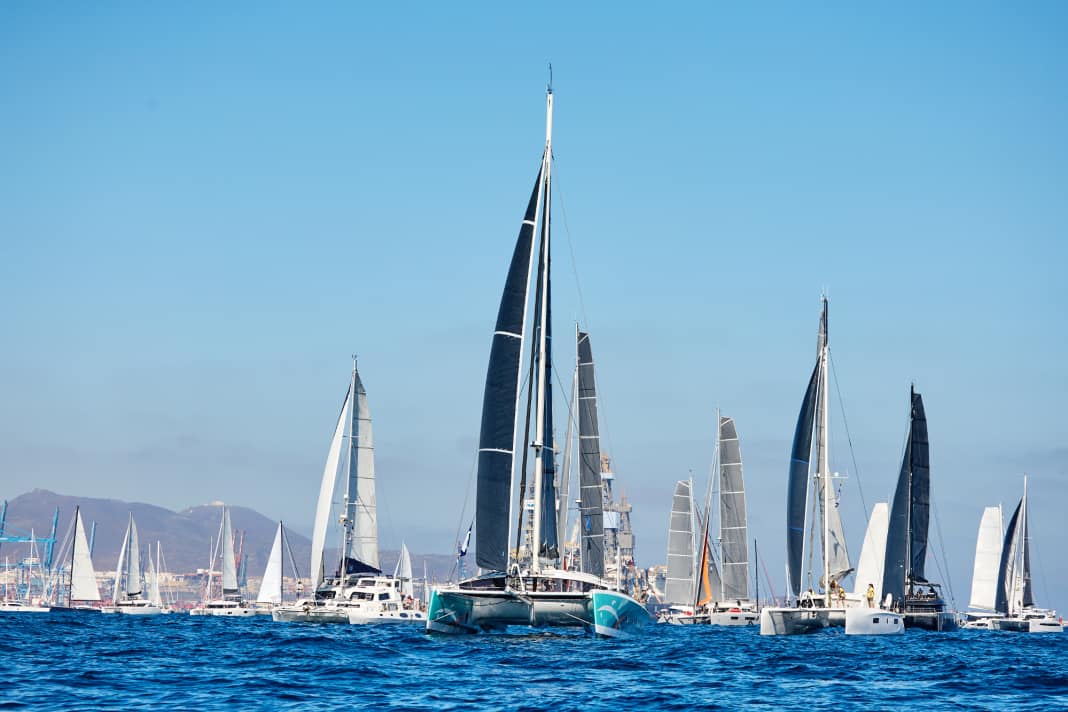
The tracker shows that the crews who opted for the more northerly route along the rhumb line, i.e. the shortest route from Las Palmas to Saint Lucia, are now initially travelling in extremely light winds. Exactly as the weather specialist from the World Cruising Club, Chris Tibbs, had predicted the day before the start. Those who have opted for a more south-easterly route will now enjoy more favourable conditions. They can hope that the trade winds will pick up over the next 24 hours.
The fleet is currently led by the large Swan 90 "Berenice Cube", which sails under the Italian flag. Close on her heels is "L'Ondine", a British Southern Wind 100, while the Oyster 82 "Bare Necessities", which also sails under the British flag, has the lead in the cruising division.
Just under 2,000 nautical miles to Saint Lucia
The ranking is likely to change again and again in the coming days, the gaps are narrow and there are still almost 2,000 nautical miles to go to the finish.
Time enough for the crews to familiarise themselves with everyday life at sea. This is obviously by no means boring, even if the sailing challenge of the Atlantic passage is not too great at the moment given the moderate conditions. For example, some stowaways are astonishing the crews. Above all, crickets have landed on several boats. You could also say: stranded. The animals have probably been blown out to sea by the Sahara winds of the past few days. The wind has dusted the boats to boot.
A very special guest has also arrived on the Windelo 50 "Joule": a kestrel. The bird, which is around 30 centimetres tall, has apparently made itself at home on board the catamaran. It remains to be seen whether it will travel all the way to the Caribbean. The falcon's diet is also likely to be a problem, as it usually eats larger insects. But who knows, perhaps crickets have also landed on the "Joule".
Marine mammals, fish and researchers
Less surprising are the sightings of numerous dolphins and whales. The crew of the "Asante" even spotted a whole group of minke whales.
Some flying fish, on the other hand, end up on deck involuntarily. Others even end up in the frying pan. The first sailors report fishing successes and proudly present impressive mahi mahi.
Meanwhile, various crews involved in the SeaLab programme are working in a completely different way. Some boats have been equipped with scientific equipment to measure and collect marine data while underway. Children also take part in the programme, such as eleven-year-old Seth on board the "Saltair".
More about the ARC:
There are also a number of family crews on the ARC per se. Most parents travelling with children opt for the ARC plus option, i.e. the stopover in Cape Verde. In this way, the long journey across the Atlantic can be divided into two stages and the children have the opportunity to meet up with the friends they made in Las Palmas. But even on the regular ARC, which sails non-stop to the Caribbean, there are children on board, from babies to teenagers.
Ship schooling and night watch
For example on the "Waymaker", a Fountaine Pajot Saona 47 owned by skipper couple Todd and Danielle Weiden, both 42, from Florida. They are sailing across the Atlantic with three boys and a girl aged 7, 9, 11 and 14. The parents have brought two additional crew members on board as nannies and to help with the sailing. After all, the children need to be schooled and sometimes entertained along the way. The older two children are also already involved in guiding the ship, Todd Weiden reported before departure. They sometimes take over the helm and also go on night watch.
On the "Vitamin Sea", a brand new Lagoon 42-2, the children are already at or close to adulthood. The Hamburg-based Hegemann family is sailing the ARC as a family of four: Father Peter, 52, mother Doreen, 50, son Nicolas, 19, and daughter Anna, 16, make up the crew. The fifth crew member is "Flash", the cat on board.
A family in search of adventure
Doreen Hegemann reported shortly before departure: "We are basically sailing beginners. But we are a family looking for adventure. When we go on holiday, we always go on our own to mostly remote regions. We find package holidays rather boring, they're not for us. Incidentally, our children go along with us and see it the same way."
The family had been preparing for the project for four years. Then came the purchase of the boat. Father and children obtained their sports boat licence and attended the numerous ARC long-distance sailing seminars in Las Palmas in the days leading up to the launch.
Children are integrated into ship management
The children are fully integrated into the sailing work and ship management. Peter Hegemann: "Anna, for example, does the harbour manoeuvres, she's really good at that." Firm safety rules have been established for the Atlantic passage: Lifejackets, pecking in, and no one leaves the cockpit alone at night. "We also practised MOB manoeuvres diligently," adds the daughter.
The ARC sails with the family because "it is the perfect vehicle for our endeavour," says father Peter Hegemann. Without the ARC, the family would not have dared to cross the Atlantic, he said. Why were they drawn to the long voyage in the first place? Peter Hegemann: "I was inspired by this concept of freedom."
Impressions from the start of ARC 2023






The ARC start day in the video summary:
The start in Re-Live:
At this point, you will find external content that complements the article. You can display and hide it with a click.

